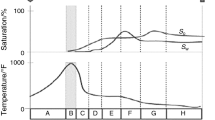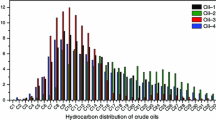Abstract
In this work a continuous investigation of the thermal behavior of two heavy crude oils, P2 and P4, from Brazilian basin was performed using simultaneous technique TG-DSC-FTIR. In previous publication—Part 1, about these same oils at nitrogen atmosphere, it was identified for P2 sample that the main evolved component was 1-dodecyl-4-octyl-cyclohexane at 450 °C and for P4 sample the main component was evolved at 340 °C referent to 1-methyl cyclohexene. The simultaneous technique TG/FTIR was also performed for the present study in synthetic air atmosphere and was more elucidative than analysis in nitrogen atmosphere. For heavy oil P2, there was identified the presence of carbon dioxide, carbon monoxide and 4-methylcyclohexanone at 382 °C. Whilst for sample P4 the gaseous components evolved at 454 °C were carbon dioxide, carbon monoxide and 1-methylcyclohexene. Also differences in TG analysis for both samples were observed regarding the number of components. In air atmosphere crude oil P2 exhibited three decomposition stages, in nitrogen were only two. Four stages were exhibited on the thermogravimetric curve for oil P4 in synthetic air, while in nitrogen atmosphere there were three stages. Thus, this study has a unique character regarding the use of combined simultaneous techniques as STA/FTIR to identify components in heavy oil which may contribute to upgrade methods referring to crude oil composition.









Similar content being viewed by others
References
ANP. Brazilian statistical yearbook of petroleum, natural gas and biofuels. 2013.
Hasan SA, Ghannam MT, Esmail N. Heavy crude oil viscosity reduction and rheology for pipeline transportation. Fuel. 2010;89:1095–100.
Brown LD. Flow Assurance: Aπ3 discipline. OTC 14010, 2002.
Martinez-Palou R, Mosqueira ML, Zapata-Rendon B, Mar-Juarez E, Bernal-Huicochea C, Clavel-Lopez JC, Aburto J. Transportation of heavy and extra-heavy crude oil by pipeline—a review. J Petrol Sci Eng. 2010. doi:10.1016/j.petrol.2010.11.020.
Mothé MG, Carvalho CHM, Jossic L, Mothé CG. Rheological behavior of biopolymers on light and heavy crude oils. Int J Rheol. 2013;01:41–3.
Amim A, Dutta-Roy K. Closing the flow assurance loop. Flow assurance, E&P. New York: Hart energy Publishing; 2005.
Kök MV, Acar C. Kinetics of crude oils combustion. J Therm Anal Calorim. 2006;83:445–9.
Ali MA, Siddiqui MAB, Zaidi SMJ. Thermal analysis of crude oils and comparison with SIMDIST and TBP distillation data. J Therm Anal Calorim. 1998;51:307–19.
Mothé MG, Leite LFM, Mothé CG. Kinetic parameters of different asphalt binders by thermal analysis. J Therm Anal Calorim. 2011;106:679–84.
Mothé MG, Carvalho CHM, Sérvulo EFC, Mothé CG. Kinetic study of heavy crude oils by thermal analysis. J Therm Anal Calorim. 2012. doi:10.1007/s10973-012-2574-1.
Mothé MG, Mothé CG, Carvalho CHM, Oliveira MCK. Thermal investigation of heavy crude oil by simultaneous TG-DSC-FTIR and EDXRF—Part 1. J Therm Anal Calorim. 2013. doi:10.1007/s10973-013-3124-1.
Raje N, Aacherekar DA, Reddy AVR. Compositional characterization of carbon electrode material: a study using simultaneous TG–DTA–FTIR. Thermochim Acta. 2009;496:143–50.
Acknowledgements
The authors would like to thank Petrobras and the Brazilian Council for Scientific and Technological Development (CNPq) for their financial support and NETZSCH - Geratebau GmbH Applications Laboratory.
Author information
Authors and Affiliations
Corresponding author
Rights and permissions
About this article
Cite this article
Mothé, M.G., Mothé, C.G., Carvalho, C.H.M. et al. Thermal evaluation of heavy crude oil by simultaneous TG-DSC-FTIR: Part 2. J Therm Anal Calorim 117, 1357–1363 (2014). https://doi.org/10.1007/s10973-014-3891-3
Received:
Accepted:
Published:
Issue Date:
DOI: https://doi.org/10.1007/s10973-014-3891-3




